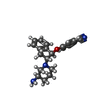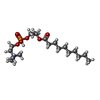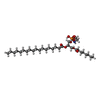[English] 日本語
 Yorodumi
Yorodumi- PDB-6uza: Cryo-EM structure of human TRPC6 in complex with antagonist AM-1473 -
+ Open data
Open data
- Basic information
Basic information
| Entry | Database: PDB / ID: 6uza | ||||||
|---|---|---|---|---|---|---|---|
| Title | Cryo-EM structure of human TRPC6 in complex with antagonist AM-1473 | ||||||
 Components Components | Short transient receptor potential channel 6 | ||||||
 Keywords Keywords | TRANSPORT PROTEIN / TRP channel / Antagonist | ||||||
| Function / homology |  Function and homology information Function and homology informationpositive regulation of ion transmembrane transporter activity / slit diaphragm / negative regulation of dendrite morphogenesis / Role of second messengers in netrin-1 signaling / store-operated calcium channel activity / Effects of PIP2 hydrolysis / Elevation of cytosolic Ca2+ levels / inositol 1,4,5 trisphosphate binding / positive regulation of calcium ion transport / cation channel complex ...positive regulation of ion transmembrane transporter activity / slit diaphragm / negative regulation of dendrite morphogenesis / Role of second messengers in netrin-1 signaling / store-operated calcium channel activity / Effects of PIP2 hydrolysis / Elevation of cytosolic Ca2+ levels / inositol 1,4,5 trisphosphate binding / positive regulation of calcium ion transport / cation channel complex / actinin binding / clathrin binding / TRP channels / monoatomic cation transport / regulation of cytosolic calcium ion concentration / single fertilization / monoatomic cation channel activity / positive regulation of neuron differentiation / calcium ion transmembrane transport / calcium channel activity / cellular response to hydrogen peroxide / neuron differentiation / positive regulation of cytosolic calcium ion concentration / actin binding / ATPase binding / cellular response to hypoxia / protein homodimerization activity / membrane / plasma membrane / cytoplasm Similarity search - Function | ||||||
| Biological species |  Homo sapiens (human) Homo sapiens (human) | ||||||
| Method | ELECTRON MICROSCOPY / single particle reconstruction / cryo EM / Resolution: 3.08 Å | ||||||
 Authors Authors | Bai, Y. / Yu, X. / Huang, X. / Chen, H. | ||||||
 Citation Citation |  Journal: Elife / Year: 2020 Journal: Elife / Year: 2020Title: Structural basis for pharmacological modulation of the TRPC6 channel. Authors: Yonghong Bai / Xinchao Yu / Hao Chen / Daniel Horne / Ryan White / Xiaosu Wu / Paul Lee / Yan Gu / Sudipa Ghimire-Rijal / Daniel C-H Lin / Xin Huang /  Abstract: Transient receptor potential canonical (TRPC) proteins form nonselective cation channels that play physiological roles in a wide variety of cells. Despite growing evidence supporting the therapeutic ...Transient receptor potential canonical (TRPC) proteins form nonselective cation channels that play physiological roles in a wide variety of cells. Despite growing evidence supporting the therapeutic potential of TRPC6 inhibition in treating pathological cardiac and renal conditions, mechanistic understanding of TRPC6 function and modulation remains obscure. Here we report cryo-EM structures of TRPC6 in both antagonist-bound and agonist-bound states. The structures reveal two novel recognition sites for the small-molecule modulators corroborated by mutagenesis data. The antagonist binds to a cytoplasm-facing pocket formed by S1-S4 and the TRP helix, whereas the agonist wedges at the subunit interface between S6 and the pore helix. Conformational changes upon ligand binding illuminate a mechanistic rationale for understanding TRPC6 modulation. Furthermore, structural and mutagenesis analyses suggest several disease-related mutations enhance channel activity by disrupting interfacial interactions. Our results provide principles of drug action that may facilitate future design of small molecules to ameliorate TRPC6-mediated diseases. | ||||||
| History |
|
- Structure visualization
Structure visualization
| Movie |
 Movie viewer Movie viewer |
|---|---|
| Structure viewer | Molecule:  Molmil Molmil Jmol/JSmol Jmol/JSmol |
- Downloads & links
Downloads & links
- Download
Download
| PDBx/mmCIF format |  6uza.cif.gz 6uza.cif.gz | 531.5 KB | Display |  PDBx/mmCIF format PDBx/mmCIF format |
|---|---|---|---|---|
| PDB format |  pdb6uza.ent.gz pdb6uza.ent.gz | 422 KB | Display |  PDB format PDB format |
| PDBx/mmJSON format |  6uza.json.gz 6uza.json.gz | Tree view |  PDBx/mmJSON format PDBx/mmJSON format | |
| Others |  Other downloads Other downloads |
-Validation report
| Summary document |  6uza_validation.pdf.gz 6uza_validation.pdf.gz | 1.7 MB | Display |  wwPDB validaton report wwPDB validaton report |
|---|---|---|---|---|
| Full document |  6uza_full_validation.pdf.gz 6uza_full_validation.pdf.gz | 1.8 MB | Display | |
| Data in XML |  6uza_validation.xml.gz 6uza_validation.xml.gz | 91.6 KB | Display | |
| Data in CIF |  6uza_validation.cif.gz 6uza_validation.cif.gz | 128.4 KB | Display | |
| Arichive directory |  https://data.pdbj.org/pub/pdb/validation_reports/uz/6uza https://data.pdbj.org/pub/pdb/validation_reports/uz/6uza ftp://data.pdbj.org/pub/pdb/validation_reports/uz/6uza ftp://data.pdbj.org/pub/pdb/validation_reports/uz/6uza | HTTPS FTP |
-Related structure data
| Related structure data |  20954MC  6uz8C C: citing same article ( M: map data used to model this data |
|---|---|
| Similar structure data |
- Links
Links
- Assembly
Assembly
| Deposited unit | 
|
|---|---|
| 1 |
|
- Components
Components
| #1: Protein | Mass: 97202.867 Da / Num. of mol.: 4 Source method: isolated from a genetically manipulated source Source: (gene. exp.)  Homo sapiens (human) / Gene: TRPC6, TRP6 / Production host: Homo sapiens (human) / Gene: TRPC6, TRP6 / Production host:  Homo sapiens (human) / References: UniProt: Q9Y210 Homo sapiens (human) / References: UniProt: Q9Y210#2: Chemical | ChemComp-R0G / #3: Chemical | ChemComp-S9Y / #4: Chemical | ChemComp-SBJ / [( #5: Chemical | ChemComp-Y01 / Has ligand of interest | Y | Has protein modification | Y | |
|---|
-Experimental details
-Experiment
| Experiment | Method: ELECTRON MICROSCOPY |
|---|---|
| EM experiment | Aggregation state: PARTICLE / 3D reconstruction method: single particle reconstruction |
- Sample preparation
Sample preparation
| Component | Name: TRPC6 / Type: ORGANELLE OR CELLULAR COMPONENT / Entity ID: #1 / Source: RECOMBINANT |
|---|---|
| Molecular weight | Experimental value: NO |
| Source (natural) | Organism:  Homo sapiens (human) Homo sapiens (human) |
| Source (recombinant) | Organism:  Homo sapiens (human) Homo sapiens (human) |
| Buffer solution | pH: 8 |
| Specimen | Embedding applied: NO / Shadowing applied: NO / Staining applied: NO / Vitrification applied: YES |
| Specimen support | Details: unspecified |
| Vitrification | Cryogen name: ETHANE |
- Electron microscopy imaging
Electron microscopy imaging
| Experimental equipment |  Model: Titan Krios / Image courtesy: FEI Company |
|---|---|
| Microscopy | Model: FEI TITAN KRIOS |
| Electron gun | Electron source:  FIELD EMISSION GUN / Accelerating voltage: 300 kV / Illumination mode: FLOOD BEAM FIELD EMISSION GUN / Accelerating voltage: 300 kV / Illumination mode: FLOOD BEAM |
| Electron lens | Mode: BRIGHT FIELD |
| Image recording | Electron dose: 50 e/Å2 / Detector mode: SUPER-RESOLUTION / Film or detector model: GATAN K2 SUMMIT (4k x 4k) |
- Processing
Processing
| Software |
| ||||||||||||||||||||||||
|---|---|---|---|---|---|---|---|---|---|---|---|---|---|---|---|---|---|---|---|---|---|---|---|---|---|
| CTF correction | Type: PHASE FLIPPING AND AMPLITUDE CORRECTION | ||||||||||||||||||||||||
| 3D reconstruction | Resolution: 3.08 Å / Resolution method: FSC 0.143 CUT-OFF / Num. of particles: 90014 / Symmetry type: POINT | ||||||||||||||||||||||||
| Refinement | Stereochemistry target values: CDL v1.2 | ||||||||||||||||||||||||
| Refine LS restraints |
|
 Movie
Movie Controller
Controller



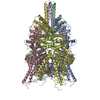




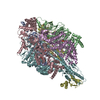


 PDBj
PDBj
